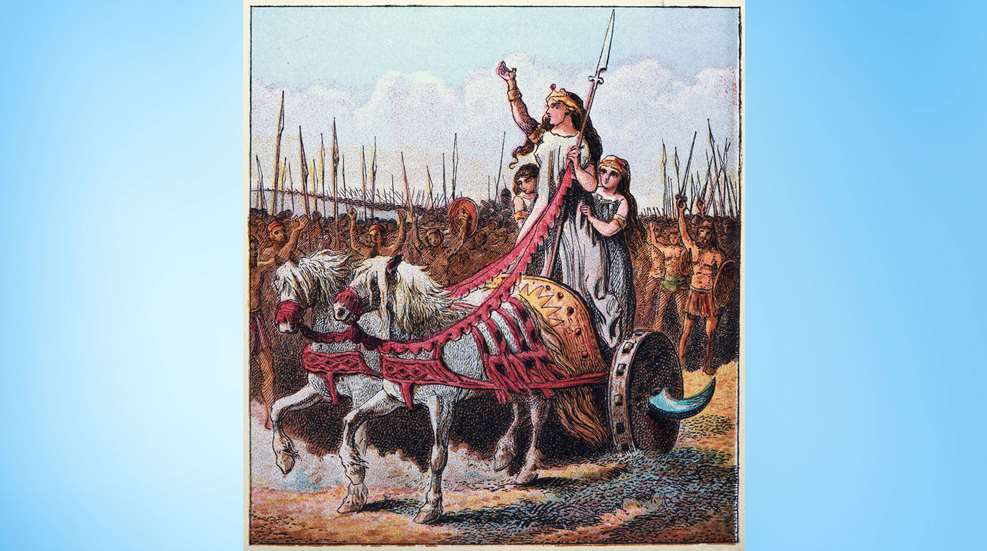
This Mother’s Day I’d like to turn back the pages of history to five mothers of the ancient world willing to give everything to protect, and sometimes avenge, their children. Caught in grisly circumstances, these daring women stepped outside of the traditional boundaries placed upon them to resist oppression, and defend those they held dear.

Boudicca—Thorn in the Side of Roman Conquerors
After the death of Boudicca’s husband, King Prasutagus, in 60 A.D., occupying Roman forces opted to ignore his will, and instead assaulted his surviving wife and daughters. Unwilling to bear this abuse, the fallen queen called her Iceni people to revolution, and began to wreak havoc on surrounding Roman territories. In quick succession, Boudicca and her allies burned multiple Roman cities, and defeated tens of thousands of their soldiers. There are no surviving direct accounts of Boudicca’s life and actions, but she was said to have given fiery speeches before battle, citing abuses against her people, their children and her own children as motivation to continue the fight. Unfortunately for the Queen and her followers, Roman governor Gaius Suetonius Paulinus was quickly dispatched to put down the rebellion and ultimately defeated the united British tribes. Though historical accounts vary, legend maintains that rather than fall into the hands of the enemy, Boudicca took her own life, determined to defy her persecutors to the very end.
 Jeanne de Clisson—Privateer of Vengeance
Jeanne de Clisson—Privateer of Vengeance
Born the daughter of minor French nobility, married and widowed multiple times, and mother to seven children, Jeanne de Clisson certainly did not have a marauder’s upbringing. In fact, it was not until her mid-forties that she would begin the vengeful crusade that earned her the title: ‘Lioness of Brittany.’ Despite siding with the French during the Briton war of succession, in 1343, Olivier de Clisson, third husband of Jeanne de Clisson and father to five of her children, was deceived into capture and executed by French authorities under the judgement of King Philip VI. Afterward, his body was desecrated and publicly displayed as a warning against political treachery. The gall of such unfounded persecution forever altered the course of Jeanne’s life, and she would spend the next thirteen years exacting her revenge. Using the proceeds from her late husband’s estate, de Clisson raised a small army and procured three ships, reportedly going as far as naming her flagship My Revenge. She then began a violent campaign of targeting French commerce vessels, slaughtering most of their crew, and ordering what few witnesses were spared to relay word of Jeanne’s brutality to King Philip VI. It’s worth noting that though the final decades of her life were largely consumed by her quest for vengeance, Jeanne remained quite forward-thinking, and conducted multiple legal endeavors to ensure the financial security and inheritances of her children were protected. Eventually recognized as something of an ‘English Ally’ for her attacks against French merchants, Jeanne would go on to receive a barony from the English with her fourth husband, and later gave up terrorizing the seas to settle at castle Hennebont.

Gráinne Mhaol (Grace O’Malley)—Master of Piracy and Diplomacy
Much like Boudicca, tales of Grace O’Malley’s impact and legacy are largely influenced by local legend. An icon of traditional Gaelic way of life and insurgent against British imperialism, the mariner chieftess is remembered today as equal parts ruthless pirate, fearless warrior, and shrewd businesswoman. O’Malley first found herself thrust into leadership after her husband, Tánaiste of the Clan O’Flaherty, was assassinated by a rival clan. With him out of the way, the would-be conquerors attempted to assume control of her castle, taking for granted that a widowed mother of three would relinquish the stronghold to avoid conflict. Instead, they found a battle-hardened leader bent on revenge, who ferociously rallied her forces and repelled the attack. Years later, that same ferocity emerged in a more refined manner, when she personally negotiated with Queen Elizabeth I for the successful release of her son and half-brother. Using wit, courage and sometimes brute force, O’Malley continued to deter British encroachment of her familial lands during her lifetime.
 Fu Hao—Militant Royal and Acolyte
Fu Hao—Militant Royal and Acolyte
Believed to have been a queen consort, military general, and high priestess during the Shang Dynasty, Fu Hao was discovered buried with many honors, including weapons, oracle bones, and traditional sacrifices. One of three high-ranking wives of King Wu Ding, Fu Hao would likely have been afforded many luxuries as mother to the crown prince, Zu Ji, though he is not believed to have lived to succeed his father. However, Fu Hao did not seem to be concerned with living a life of pampered seclusion. Historians believe she instead conducted multiple military campaigns, became a landowner in her own right, and engaged in political and religious endeavors on the king’s behalf.

Tomyris—Combatant Queen of Saka
According to Herodotus, Cyrus, founder of the Achaemenid Empire, made the mistake that would cost him his life when he decided to target Tomyris, Queen Regent of the Massagetae. Wanting to absorb her territory into his empire, Cyrus requested her hand in marriage, only to be coldly rejected. Nevertheless determined to conquer her country, the avaricious Persian leader simply declared war, and began his invasion. Initially, Cyrus experienced quick victory, and captured Tomyris’ only son, Spargapises. However, Cyrus’ fortune turned when Spargapises committed suicide to avoid being used as a prisoner of war against his mother. In a fit of rage, Tomyris swore to, ‘give him more blood than he could drink!’ as vengeance for the loss of her child. True to her word, Tomyris and her forces are believed to have defeated Cyrus and his army in battle, though lore varies in the specific details (some more gruesome than others) of her victory.















































